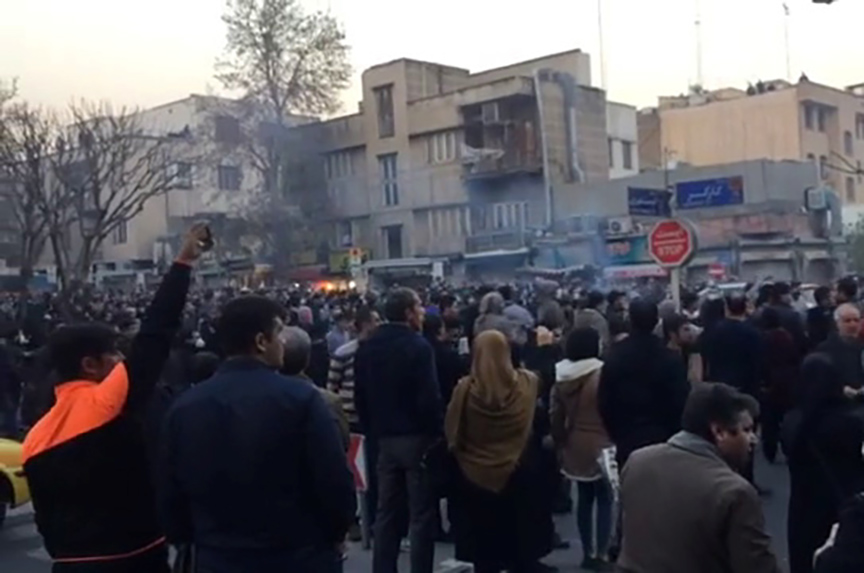 For forty years, the Islamic Republic of Iran has encouraged, even demanded, that its citizens participate in mass demonstrations. Repeatedly, however, Iranians have taken to the streets not to praise the regime, but to protest its policies.
For forty years, the Islamic Republic of Iran has encouraged, even demanded, that its citizens participate in mass demonstrations. Repeatedly, however, Iranians have taken to the streets not to praise the regime, but to protest its policies.
The latest protests began December 28, in Mashhad, a conservative city and home to a major Shi’ite Muslim shrine. The government responded by restricting access to social media apps such as Instagram and Telegram as the demonstrations spread through small, provincial cities. While political slogans have been chanted, the main initial grievances appear to be economic—rising inflation and unemployment.
More than twenty people have died since the protests began.
US President Donald J. Trump has tweeted his support for demonstrators against the regime, to little apparent effect. Meanwhile, Iranian Supreme Leader Ayatollah Ali Khamenei blamed the protests on the enemies of Iran, rather than its citizens.
From Friday prayers to the anniversary of the 1979 revolution, Iranians have been encouraged, if not obliged, by the government to gather in large numbers to chant slogans in support of the system and against Iran’s declared enemies.
Yet repeatedly, they have taken to the streets to protest that system. Through student demonstrations in support of freedom of the press in 1999 and mammoth marches in Tehran a decade later against fraud-tainted elections, Iranians have reveled in the right to make their voices heard. The latest unrest is well within this tradition, with new characteristics.
Unlike the protests of 2009, this time the protestors come largely from the regime’s working-class base, not the effete wealthy of north Tehran. They are demanding cheaper food, more jobs and less government corruption.
Critics of Tehran in Washington have been quick to see the seeds of a new revolution in the most recent protests. However, that analysis is premature. Unlike previous protests, there are no evident leaders or organization to these demonstrations.
Further, the Iranian government has thus far responded with relative restraint, and appears to have used force as a last resort to protect public property.
This does not diminish the significance of these events. Indeed, in some ways they mark a deeper challenge to Iran’s unique political system, which splits authority between elected and unelected institutions and individuals, and features a rough division between reformist and conservative factions.
While some hardline factions, supportive of the regime, appear to sympathize with the protestors—and may have even incited the initial unrest in Mashhad—the conservatives had their chance to address economic grievances when Mahmoud Ahmadinejad was president from 2006 to 2013, but came up short. Indeed, many of Iran’s current economic woes date back to Ahmadinejad’s tenure.
Reformists, led by Iranian President Hassan Rouhani thought they had found the solution to Iran’s economic problems by reaching a landmark nuclear agreement—the Joint Comprehensive Plan of Action (JCPOA)—with the United States and other world powers in 2015. However, expectations for foreign investment, always a bit inflated, have been dashed by the Trump administration’s hostility to the JCPOA. After de-certifying Iran’s compliance with the terms of the deal, Trump must decide within the next few weeks whether to waive nuclear-related sanctions or withdraw entirely from the agreement.
Rouhani’s attempts to enact reform have also been stymied by institutional challenges, including continued hardline control of the judiciary and security organs and widespread corruption. While Iranian society has become increasingly liberal in terms of women’s dress and public entertainment, Iran still has scores of political prisoners including Iranian Americans and other dual nationals jailed on trumped-up charges. The political system in Tehran excludes all those who openly oppose clerical control.
The country also continues costly intervention in foreign wars in Yemen, Syria, and Iraq; provides weapons and other support to Hezbollah, the powerful Shi’ite organization in Lebanon; and backs militant Palestinian factions against Israel.
Iranians have always resented such interference in what they deem “Arab” causes, but especially so at a time of economic challenges at home.
At this juncture, it is difficult to see how the regime can meet the demands of the protestors beyond increasing cash handouts or instituting price controls. The price of oil remains relatively low and the unrest on the streets will be a further disincentive to Western businesses already spooked by the Trump administration’s antipathy toward Iran.
Yet Iranians have shown a great ability to make lemonade out of the lemons of their political system, and there is no shortage of thoughtful people within the Rouhani administration who support economic and social reform.
It will be tempting for members of the regime to blame outsiders for the unrest—as Khamenei has just done—but no one inside or outside Iran will be persuaded. It is long past time for Iran to shed the revolutionary jargon of forty years ago, and to project an Iran that is modern, pragmatic, and responsive to the desires of its well-educated population. The United States should wish Iranians well and not presume to dictate their future.
Barbara Slavin is director of the Future of Iran Initiative at the Atlantic Council.
Image: Anti-government protesters are seen in Tehran, Iran, on December 30 in this still image from a video obtained by Reuters.

